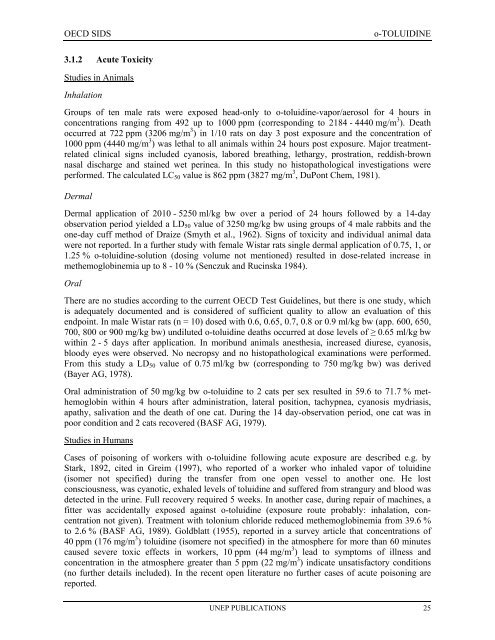o-TOLUIDINE CAS N°: 95-53-4 - UNEP Chemicals
o-TOLUIDINE CAS N°: 95-53-4 - UNEP Chemicals
o-TOLUIDINE CAS N°: 95-53-4 - UNEP Chemicals
You also want an ePaper? Increase the reach of your titles
YUMPU automatically turns print PDFs into web optimized ePapers that Google loves.
OECD SIDS o-<strong>TOLUIDINE</strong><br />
3.1.2 Acute Toxicity<br />
Studies in Animals<br />
Inhalation<br />
Groups of ten male rats were exposed head-only to o-toluidine-vapor/aerosol for 4 hours in<br />
concentrations ranging from 492 up to 1000 ppm (corresponding to 2184 - 4440 mg/m 3 ). Death<br />
occurred at 722 ppm (3206 mg/m 3 ) in 1/10 rats on day 3 post exposure and the concentration of<br />
1000 ppm (4440 mg/m 3 ) was lethal to all animals within 24 hours post exposure. Major treatmentrelated<br />
clinical signs included cyanosis, labored breathing, lethargy, prostration, reddish-brown<br />
nasal discharge and stained wet perinea. In this study no histopathological investigations were<br />
performed. The calculated LC50 value is 862 ppm (3827 mg/m 3 , DuPont Chem, 1981).<br />
Dermal<br />
Dermal application of 2010 - 5250 ml/kg bw over a period of 24 hours followed by a 14-day<br />
observation period yielded a LD50 value of 3250 mg/kg bw using groups of 4 male rabbits and the<br />
one-day cuff method of Draize (Smyth et al., 1962). Signs of toxicity and individual animal data<br />
were not reported. In a further study with female Wistar rats single dermal application of 0.75, 1, or<br />
1.25 % o-toluidine-solution (dosing volume not mentioned) resulted in dose-related increase in<br />
methemoglobinemia up to 8 - 10 % (Senczuk and Rucinska 1984).<br />
Oral<br />
There are no studies according to the current OECD Test Guidelines, but there is one study, which<br />
is adequately documented and is considered of sufficient quality to allow an evaluation of this<br />
endpoint. In male Wistar rats (n = 10) dosed with 0.6, 0.65, 0.7, 0.8 or 0.9 ml/kg bw (app. 600, 650,<br />
700, 800 or 900 mg/kg bw) undiluted o-toluidine deaths occurred at dose levels of ≥ 0.65 ml/kg bw<br />
within 2 - 5 days after application. In moribund animals anesthesia, increased diurese, cyanosis,<br />
bloody eyes were observed. No necropsy and no histopathological examinations were performed.<br />
From this study a LD50 value of 0.75 ml/kg bw (corresponding to 750 mg/kg bw) was derived<br />
(Bayer AG, 1978).<br />
Oral administration of 50 mg/kg bw o-toluidine to 2 cats per sex resulted in 59.6 to 71.7 % methemoglobin<br />
within 4 hours after administration, lateral position, tachypnea, cyanosis mydriasis,<br />
apathy, salivation and the death of one cat. During the 14 day-observation period, one cat was in<br />
poor condition and 2 cats recovered (BASF AG, 1979).<br />
Studies in Humans<br />
Cases of poisoning of workers with o-toluidine following acute exposure are described e.g. by<br />
Stark, 1892, cited in Greim (1997), who reported of a worker who inhaled vapor of toluidine<br />
(isomer not specified) during the transfer from one open vessel to another one. He lost<br />
consciousness, was cyanotic, exhaled levels of toluidine and suffered from strangury and blood was<br />
detected in the urine. Full recovery required 5 weeks. In another case, during repair of machines, a<br />
fitter was accidentally exposed against o-toluidine (exposure route probably: inhalation, concentration<br />
not given). Treatment with tolonium chloride reduced methemoglobinemia from 39.6 %<br />
to 2.6 % (BASF AG, 1989). Goldblatt (1<strong>95</strong>5), reported in a survey article that concentrations of<br />
40 ppm (176 mg/m 3 ) toluidine (isomere not specified) in the atmosphere for more than 60 minutes<br />
caused severe toxic effects in workers, 10 ppm (44 mg/m 3 ) lead to symptoms of illness and<br />
concentration in the atmosphere greater than 5 ppm (22 mg/m 3 ) indicate unsatisfactory conditions<br />
(no further details included). In the recent open literature no further cases of acute poisoning are<br />
reported.<br />
<strong>UNEP</strong> PUBLICATIONS 25
















